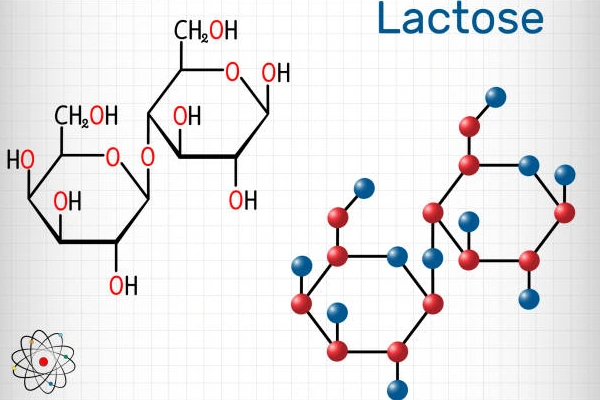what is lactose

Lactose is not just a sweetener. This carbohydrate plays an important role in human nutrition and physiology, helping to absorb vital minerals such as calcium. On the other hand, for some people who lack the necessary enzyme to digest it, lactose can cause problems. In this article, we intend to take a deeper look at this complex sugar: from its molecular structure and its important roles in the body, to an examination of its types, as well as the topic of lactose sensitivity and intolerance, which is important for many people.
What is Lactose?
Lactose, often known as milk sugar, is a naturally occurring carbohydrate found abundantly in milk and dairy products. It is formed from the combination of two simpler sugars called glucose and galactose. Lactose is not only an important source of energy for the body, especially during infancy, but it also plays a vital role in improving calcium absorption and, consequently, maintaining bone health. For the body to be able to digest and absorb lactose, it needs an enzyme called lactase, which breaks this sugar down into its constituent components. If the body does not produce enough of this enzyme, a person develops a condition called lactose intolerance, which can be accompanied by unpleasant digestive symptoms.
Lactose is a disaccharide, meaning it is composed of two simpler sugar units (monosaccharides) called D-glucose and D-galactose. These two units are connected to each other by a specific chemical bond called a beta-1,4 glycosidic bond. Due to this structure, the full chemical name for lactose is beta-D-galactopyranosyl-(1→4)-D-glucopyranose. Since the lactose molecule has a free anomeric carbon in its glucose unit, it is classified as a reducing sugar. Additionally, lactose can exist in two different isomeric forms called alpha-lactose and beta-lactose, which affect its physical and chemical properties.

Benefits of Lactose
This natural sugar, beyond being a simple sweetener, plays key roles in the body's health. The benefits of lactose, from providing energy to aiding in the absorption of vital minerals, make it an important element in nutrition. Below, we will comprehensively examine these benefits and the important roles of lactose in the body.
Energy Supply
Lactose acts as an important source of energy for the body. After consumption, the enzyme lactase breaks it down into two simpler sugars, namely glucose and galactose. Glucose is rapidly absorbed into the bloodstream and is the main source of fuel for the body's cells, especially for the brain and muscles. In fact, glucose provides the necessary energy for daily activities and the proper functioning of the body's systems. Galactose is also transported to the liver and can be converted to glucose to be used for energy supply.
Improved Mineral Absorption
One of the most important benefits of lactose is its role in improving the absorption of calcium, magnesium, and phosphorus. Lactose binds to calcium and helps it to be absorbed from the intestine into the bloodstream. This process is vital for strengthening bones and teeth and helps prevent diseases such as osteoporosis. This property is particularly important during childhood growth and also in adults for maintaining bone health.
Source of Protein
Dairy products that contain lactose are also considered a rich source of protein. The proteins in milk, such as casein and whey proteins, help promote a long-lasting feeling of satiety and, as a result, are effective in weight management. These proteins are essential for repairing and building body tissues, producing enzymes and hormones, and strengthening the immune system.
Prebiotic Effects
Lactose can act as a prebiotic, meaning it is food for beneficial gut bacteria. When lactose is not completely digested in the small intestine, it reaches the large intestine and is fermented by probiotic bacteria. This process leads to the growth and proliferation of beneficial bacteria and helps maintain the balance of the gut microbiome. These healthy bacteria are essential for the health of the digestive system, strengthening the immune system, and even improving mood.

Natural or Added Lactose?
Lactose can be used in two forms: natural and added (or artificial). Lactose is naturally found in the milk of mammals and is present in products such as milk, yogurt, cheese, and ice cream as part of their main ingredients. However, lactose can also be extracted from its primary source and used as an additive in the processing of various food products. In this case, lactose is used to improve the taste, texture, or increase the shelf life of products such as caramel, sauces, and ready-made soups, which is referred to as added sugar or added lactose. Therefore, although the origin of lactose is always natural, its type of consumption determines whether it is classified as a natural sugar or as an additive.
Dietary Sources of Lactose
Lactose, in addition to being naturally present in milk and its products, is also used as an additive in various food industries. For this reason, sources of lactose are not limited to dairy products and are also found in many processed foods.
Milk and dairy products: The main source of lactose is the milk of cows, goats, and sheep. The amount of lactose in these products varies; for example, cow's milk contains about 5% lactose and human milk about 6.5%. Products like yogurt, cheese, and ice cream are also major sources of lactose. Of course, the amount of lactose in hard, aged cheeses (like cheddar or parmesan) is lower than in fresh, soft cheeses (like cream cheese) due to the production process.
Cream cheese and soft cheeses: These types of cheeses contain a higher amount of lactose than aged cheeses due to their production process.
Breakfast cereals and baked goods: Many breakfast cereals, biscuits, cookies, and other baked goods contain milk powder or whey powder to improve taste, texture, and color, both of which are high in lactose.
Sausages and cold cuts: In the processing of some types of processed meats like sausages and cold cuts, lactose is used to improve texture and shelf life.
Ready-made soups and sauces: Many ready-made soups and sauces available in stores contain milk powder or lactose to create a creamy and thick texture.
Instant coffee and powdered drinks: Many instant drink powders, such as instant coffee or hot chocolate, contain milk powder or dairy ingredients, of which lactose is a main component, to create a creamy taste.
Sweets and chocolates: Milk chocolate and some types of sweets and caramels also contain lactose.

How Lactose is Digested in the Body
For lactose to be absorbed by the body, it must be broken down in the small intestine. This is done by an enzyme called lactase, which converts lactose into two simpler sugars: glucose and galactose. After breakdown, glucose is directly absorbed by the body's cells to be used as a primary source of energy. Galactose is also transported to the liver to be converted into glucose, providing the energy the body needs.
Lactase Production from Birth to Adulthood
All humans are born with the ability to produce the lactase enzyme, as it is essential for digesting the lactose in mother's milk. Lactase production reaches its maximum level during infancy, but its production gradually decreases with age and after the weaning period. This natural decline does not cause a problem for many people, but in others, it can reach a point that leads to an inability to digest lactose. In very rare cases, some infants are born with a deficiency of this enzyme, which is called "congenital alactasia." Research shows that about two-thirds of the world's population in adulthood do not produce enough lactase enzyme to digest lactose.
Lactose Intolerance
Lactose intolerance refers to a condition in which the body is unable to completely digest lactose, the sugar found in dairy products. This problem is due to a deficiency or lack of production of an enzyme called lactase in the small intestine, which is responsible for breaking down lactose. When undigested lactose reaches the large intestine, it is fermented by gut bacteria. This process produces gas and acid, which leads to unpleasant symptoms such as bloating, abdominal cramps, diarrhea, and gas.

Causes of Lactose Intolerance
The main cause of this condition is a decrease in lactase activity, which can have two major reasons:
Genetic decrease in lactase enzyme:** The most common cause is hereditary. With increasing age, the production of the lactase enzyme naturally decreases in many people. This trend is more common in some ethnicities and geographical regions.
Damage to the small intestine:** In some cases, damage to the inner lining of the small intestine can cause a decrease in lactase enzyme production. This damage may result from gastrointestinal infections, inflammatory bowel diseases (such as Crohn's disease), or surgery.
Difference Between Lactose Intolerance and Milk Allergy
It is important to note that lactose intolerance is different from a milk allergy. Lactose intolerance is a digestive problem that occurs due to an enzyme deficiency and does not involve an immune system reaction. However, a milk allergy is an immune reaction in which the body reacts to the proteins in milk (not its sugar) and can lead to more serious symptoms such as skin rashes, respiratory problems, or anaphylaxis.
What are Lactose Tablets and Syrups?
Lactose tablets or syrup, marketed under various trade names including Tilactase, are an enzyme supplement designed to help people with lactose intolerance. This supplement contains the lactase enzyme, which helps the body break down and digest the lactose sugar present in dairy products. By taking these tablets, a person can consume lactose-containing foods and drinks without experiencing unpleasant symptoms like bloating, abdominal pain, and diarrhea. These supplements are usually taken before or with the consumption of lactose-containing foods and are an effective and efficient solution for individuals who have a deficiency of this enzyme for genetic reasons or due to intestinal damage.
Final Words
As we have discussed in this article, lactose is an important and complex carbohydrate that plays a role far beyond that of a simple sugar. From providing energy and aiding in calcium absorption to its prebiotic role, lactose is an inseparable component of milk and many food products. However, the inability to digest it, known as lactose intolerance, can create challenges for some individuals.
Fortunately, awareness of lactose sources and its management strategies, including the use of lactose-free dairy products or enzyme supplements, allows individuals to maintain a healthy and varied diet. A proper understanding of this sugar helps us make the best choices for our health according to our body's needs.
Pershia Kamandar Paytakht company (a supplier of chemical raw materials), as one of the pioneers in the field of supplying pharmaceutical raw materials, plays a vital role in meeting the needs of Iran's pharmaceutical industry. This company, with a focus on quality and standards, imports the raw materials needed for the production of various drugs from the world's leading manufacturers. The activity of Pershia Kamandar Paytakht not only helps to improve the quality and effectiveness of domestically produced drugs but also contributes to the stability of the supply chain in this sensitive and strategic industry.
Contact Us
Anytime you need, we are here for you!
To inquire about the price of chemical and industrial products, please enter your contact information in the form below.
North Sohrawardi, Khorramshahr St., Murghab St., No. 3, Unit 3
